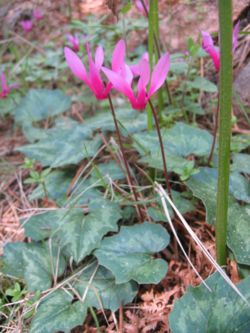| Cyclamen repandum | |
|---|---|
 | |
| Scientific classification | |
| Kingdom: | Plantae |
| Clade: | Tracheophytes |
| Clade: | Angiosperms |
| Clade: | Eudicots |
| Clade: | Asterids |
| Order: | Ericales |
| Family: | Primulaceae |
| Genus: | Cyclamen |
| Subgenus: | C. subg. Psilanthum |
| Species: | C. repandum |
| Binomial name | |
| Cyclamen repandum | |
Cyclamen repandum, the spring sowbread, [1] is a species of flowering plant in the family Primulaceae, native to southern Europe and some Mediterranean islands. It is the most widespread of a group of cyclamens (genus Cyclamen subgenus Psilanthum ) with wide, heart-shaped leaves, often coarsely toothed or lobed, and late spring-blooming flowers with long, slender petals.